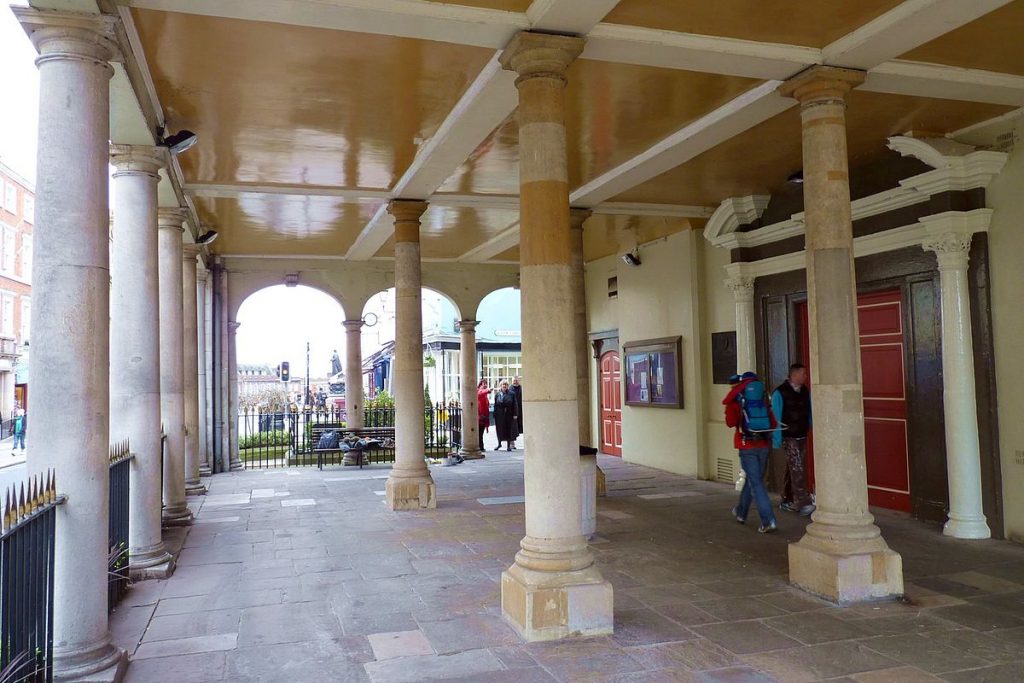
To listen to this reflection as a podcast, click here.
The Windsor Guildhall, which serves as the town hall for the community of Windsor in the county of Berkshire, England, has two claims to fame.
In recent years it’s become a fashionable place for celebrity weddings.
On April 9, 2005, Prince Charles and his longtime mistress Camilla Parker Bowles (now the king and queen of England) were wed inside the Guildhall. And on December 21 of that same year, pop singer Sir Elton John (whose song Candle in the Wind had provided the most poignant moment during the funeral of Charles’ first wife, Princess Diana) married his longtime partner David Furnish.
For the last 300 years, however, the Guildhall has chiefly been famous for an architectural quirk.
The hall was originally a “corn market,” an open air courtyard where grain could be stored and sold. When the architect Sir Thomas Fitch was hired in 1687 to expand the structure, he contemplated a heavy building atop the corn market, supported by stone columns.
Fitch, unfortunately, died two years later, before the work could be completed. This is the point at which history and legend become entangled.
The story has long been told that the project now fell into the hands of Sir Christopher Wren, arguably the most famous architect in English history. As the building neared completion, civic authorities were alarmed to discover that Wren had decided to leave most of the courtyard roof unsupported. The architect countered that with regard to stability, the hall seemed to be doing quite well, thank you. But the folks who wrote the checks refused to pay him until he added more columns.
Wren complied. Sort of.
He added four more stone columns in the center of the old corn market courtyard. But if you look carefully at the picture above, you’ll notice the narrow gap between the very top of the columns and the heavy roof. Each column is approximately a half-inch too short. Since the building remains standing today, it appears Wren found a clever way to prove he was right all along.
It’s a great story, and it would be wonderful if we knew it to be true.
But historians so far have found no evidence that Christopher Wren ever lifted a finger to help with the design and construction of the Windsor Guildhall. At that very time he was in the thick of supervising the reconstruction of St. Paul’s Cathedral in London, along with, amazingly, 51 other churches. So, his hands were definitely full.
The best evidence is that the four columns were moved into place in the corn market much later, in 1829, when they became available because of renovations to another part of the Guildhall.
The fact remains, however, that they are entirely unnecessary architecturally. The outer columns are load-bearing. The four inner columns are cosmetic. They’re just for show.
And that should get our attention – especially because Jesus of Nazareth, the carpenter’s son, made some important observations about construction.
According to Jesus, building a life is like building a house. All of us are building a life. That’s not negotiable. Storms and floods will one day beat against our lives. Major turbulence will test the integrity of what we have built. That’s not negotiable, either.
Here are his words in Matthew 7:24-27, according to Eugene Peterson’s rendering in The Message:
“These words I speak to you are not incidental additions to your life, homeowner improvements to your standard of living. They are foundational words, words to build a life on. If you work these words into your life, you are like a smart carpenter who built his house on solid rock. Rain poured down, the river flooded, a tornado hit—but nothing moved that house. It was fixed to the rock.
“But if you just use my words in Bible studies and don’t work them into your life, you are like a stupid carpenter who built his house on the sandy beach. When a storm rolled in and the waves came up, it collapsed like a house of cards.”
From the perspective of the Windsor Guildhall, we can put it like this:
If you commit yourself to strengthening the load-bearing columns of your life – the attitudes and practices that hold your very life together – you will stand strong. But if you spend most of your time and energy tending the cosmetic columns of your life, which are just for show, you’re headed for a catastrophic collapse.
Cosmetic columns masquerade as the real thing. We may even convince ourselves we have to have them in order to have a life worth living: a prestigious job, a physique that turns heads, Facebook-worthy vacations, framed degrees on the wall, a double-column obituary the day after you die.
But cosmetic columns cannot bear the excruciating weight of real life. Nor can they satisfy the deepest hungers of the soul.
Jesus assures us that our job assignment this week, and every week, is not that complicated:
Love God. Love people. Embrace his words. Put them into practice.
When it comes to putting our own houses in order, we don’t want to end up a half-inch short.
